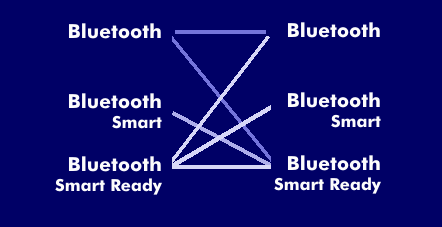Bluetooth smart
The Bluetooth standards are developed by the Bluetooth Special Interest Group( BSIG). With Bluetooth 4.0, the BSIG has developed an energy-efficient Bluetooth version that is smarter and consumes significantly less power than previous versions. That's why Bluetooth 4.0 also goes by the name Bluetooth Low Energy( BLE) and distinguishes between two versions: Bluetooth Smart and Bluetooth Smart Ready.
Because of its low energy consumption, Bluetooth 4.0 is suitable for building automation and the transmission of sensor values, for example in telemedicine, sports and fitness applications. According to the embodiments, Bluetooth 4.0 recognizes two device types: Smart Devices and Smart Ready Devices. Devices of both groups are marked with a corresponding logo.
The Smart Ready Devices are virtually the primary devices such as smartphones, tablets and notebooks. They are those devices that can receive Bluetooth signals from speakers, headphones, smart wristbands, data glasses, computer watches, smart wearables or medical monitoring devices and forward them to smaller smart devices. Smart Ready Devices typically have a dual- mode RF part and can also operate at Enhanced Data Rate( EDR). In contrast, Smart Devices are Smart Peripherals, sensors that collect readings and transmit them to the Smart Ready Devices.
There are compatibility issues between classic Bluetooth devices and the Smart Devices and Smart Ready Devices. For example, classic Bluetooth devices are compatible with classic devices and with Smart Ready devices. Smart Ready devices, on the other hand, are compatible with all other devices, and Smart devices are only compatible with Smart Ready devices because only they can provide communication.
Smart Bluetooth is the leading standard for data transmission between smart wearables and smartphones. According to the ideas of the Special Interest Group( SIG), the wireless protocol will also play an important role in the Internet of Things( IoT). In order to make the applications of the smart devices accessible to a wider range of users, they are supported by various apps.
Further Bluetooth 4.x versions
The further development of Bluetooth 4.0 leads to Bluetooth 4.1, which has several improvements over the previous version. This concerns the functionality of the devices as well as a better connection setup. Functionally, 4.1 devices can act as peripherals and also as a hub. This has the advantage that fitness data from a smart wristband can be stored on a computer watch, for example. Furthermore, the Internet Protocol Support Profile( IPSP) is integrated via which a connection to the Internet can be established.
Bluetooth 4.2 has power-saving features to extend battery life based on the conceptual relocation of certain functions. In addition, the 4.2 version has a shorter response time. The energy-saving function makes Bluetooth 4.2 suitable for use in the Wireless Internet of Things(WIoT).

